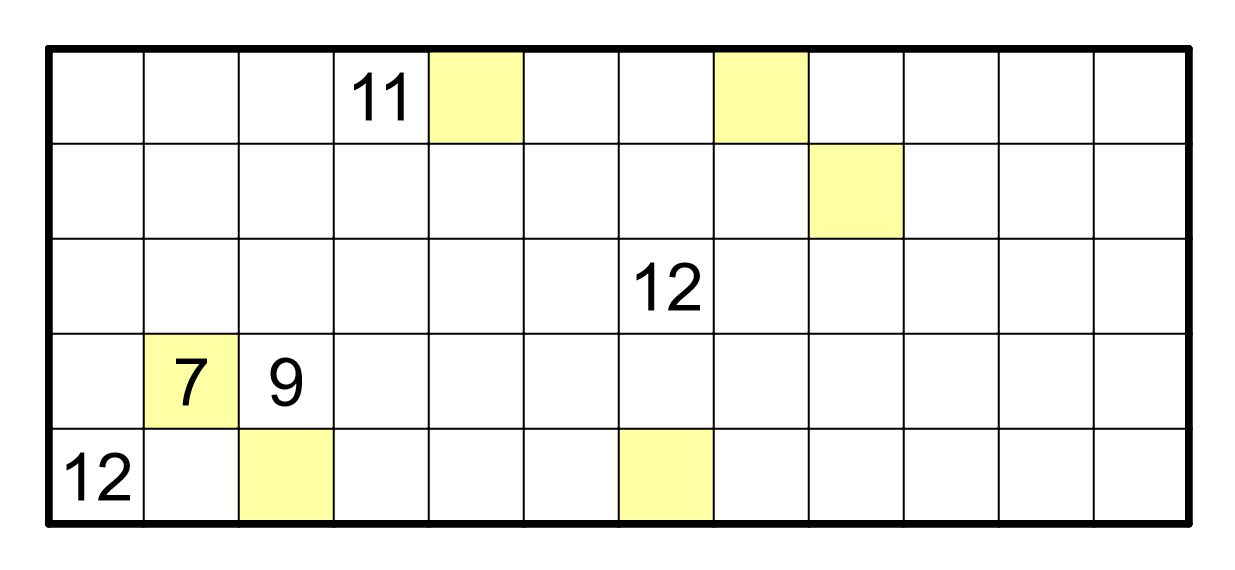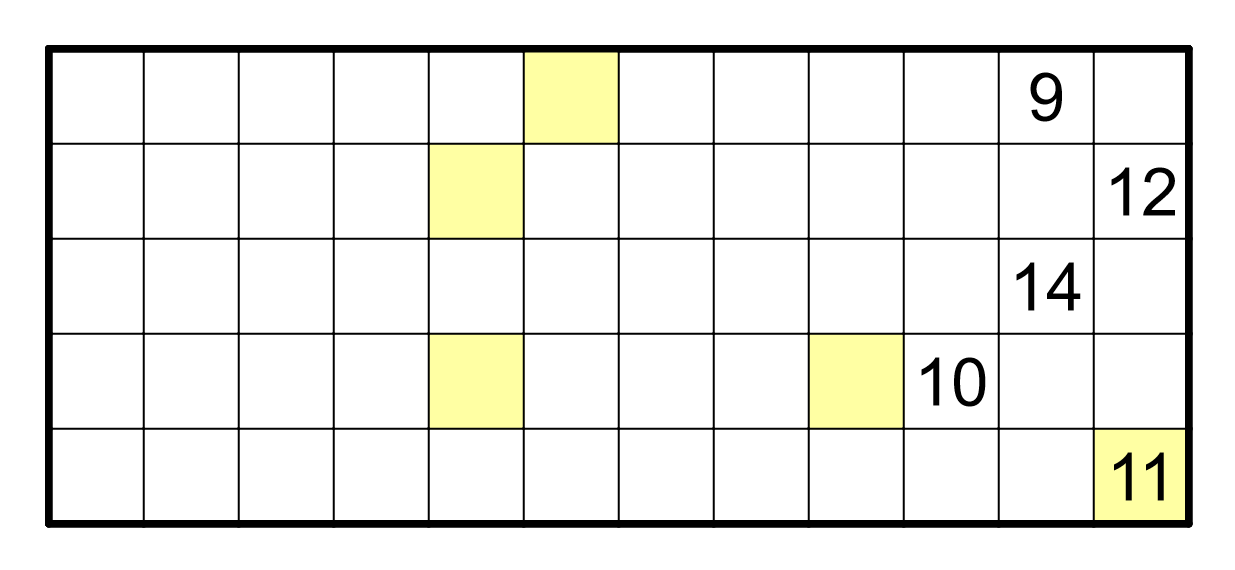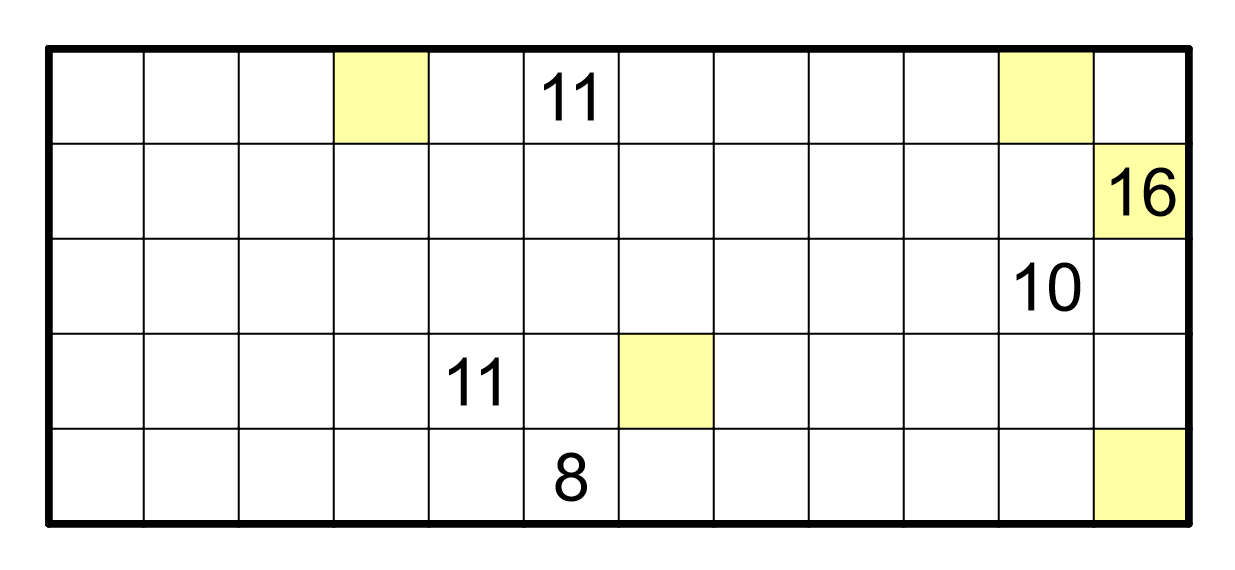Solution: Meta Bingo
Answer: RED LINGCOD
Written by chimpaznee and quatrevingtneuf
Upon opening this puzzle, we are greeted with a list of 25 seemingly-unrelated words and phrases, followed by a series of smaller puzzles, or minipuzzles. Upon trying and failing to solve the minipuzzles, we should find out that they’re all impossible. What were the authors thinking?
There is a trick, though. The title of the puzzle includes the word “meta” - this is an oblique clue to the concept of metapuzzles - puzzles that use previous puzzles’ answers. While there are no “previous puzzles” to speak of here, there is that mysterious list of 25 words and phrases. If we try to use these words or phrases to solve the minipuzzles, we’ll quickly find the first 5 very solvable. There is no indication of which answer feeds into which minipuzzle, but with some trial and error, we’ll be able to match 5 answers to each of the first 5 minipuzzles, with each answer only being used once.
After solving the first 5 minipuzzles, we’ll want to use their answers to solve the last minipuzzle - a bingo card. Its answer - RED LINGCOD - will also be the whole puzzle’s final answer.
Here is a detailed breakdown of the solutions to the individual minipuzzles:
Chatty Leaders
This meta is themed around music. Specifically, it is about Talking Heads (“Chatty Leaders”)!
Just like the title of the puzzle, each song title in the puzzle is only a clue for the actual song. Once we identify the songs, we should be able to find the answers in the lyrics. There are multiple versions of the lyrics, but through trial and error we find that the correct lyrics appear in the site Genius (don’t worry, we’re good puzzle writers, but the editor told us that we had to include an ambiguous step somewhere).
| Answer | Song | Line clue |
|---|---|---|
 |
Existence in a Period of Conflict | ↓6 |
 |
Loony Slayer | ↓16 |
 |
(Only) Blooms | ↓44 |
 |
Voltaic String Instrument | ↓2 |
 |
Producing Wibbly Wobbly | ↓42 |
In addition to the song titles, we are also presented with numbers and down arrows. For each answer, we travel that many lines down in the lyrics. (Blank lines are not counted). In all cases, the length of the answer matches the number of words in the target line.
The answers also have a curious property: each of them has a single Talking Head! We can use the position of the Talking Head in the answers to extract specific words from the target lines.
To extract the final answer, we need to use the theme of the puzzle once again, and take the Talking Head of each target word, this time using a different interpretation of “Talking Head”. These Talking Heads, when read in order, sound out the final answer.
Corrals
This meta includes three grids that contain numbers and some yellow cells. From the title of the meta, and perhaps either googling a subset of the answers, or a stroke of genius, we should realize that exactly five of the answers are animals. We’ll want to find a way to “corral” these animals inside the grids. Ordered by ascending length, the answers are  ,
,  ,
,  ,
,  and
and  .
.


 (these image may be clicked to for interactive links)
(these image may be clicked to for interactive links)
The title of the puzzle is also a reference to a popular type of logic puzzle - Corral (also known as Cave). We’ll then want to solve these grids using Corral rules. But we’ll quickly find out that each grid has multiple solutions - that’s against the most basic rules of grid logic puzzles!
To achieve a unique solution in each grid, we’ll want to consider that we’re trying to corral five animals in it. Each animal needs to occupy an unbroken run of unshaded cells in a single row, reading horizontally from left to right. None of the unshaded cells should be unoccupied by an animal - this is to prevent them from escaping. The animals also have specific lengths, which happen to be unique. By taking all of these rules into account, the number of solutions for each grid is reduced to just one.
When we find the solutions to the three grids, we’ll be able to corral the animals. To extract the final answer, we’ll need to inspect the letters in the yellow cells. We’ll quickly notice that when there are multiple yellow cells for a single animal, they always contain the same letter. Specifically, for each animal, all copies of the letter to extract will be highlighted.
We’ll need to ignore the number of copies of each letter, and always extract one letter per animal per grid (with the exception of the animal in the middle row of each grid, which does not give a letter). The extracted letters, when read from top to bottom and in the given order of the grids, spell out the final answer.
Elementary Math
After glancing at the answer list, it should be apparent that some of them consist entirely of elements.
Well, mostly. The first letters are sometimes elements, but sometimes not. Because of this inconsistency, we'll ignore the first letters entirely when doing the calculations.
To solve this meta, we will need to use the elements from the answers to solve the math problems. There initially doesn't seem to be a way to match answers to expressions, but we can find one by considering the unused information - the first letters. We can order the answers, such that their first letters are in strictly ascending alphabetical order (even if they're not consecutive). With the answers matched to the mathematical expressions, we'll be able to do the calculations. Replace the variables a, b and c with the elements in the order that they appear in the answers.
| Answer | Expression |
|---|---|
 |
$$\frac{a+1}{4} + \frac{b+1}{3} + \frac{c}{5} + 94$$ |
 |
$$67 + \frac{a+232}{b+4-\frac{a+232}{b+4-\frac{a+232}{b+4-\dots}}}$$ |
 |
$$- \sqrt[6]{b-32} + \sum_{n=0}^{\sqrt[5]{c+14}} \left( \frac{an}{4} \right)$$ |
 |
$$\frac{(2(c-a)+38)^{1.5}-15}{b}$$ |
 |
$$\frac{91637}{abc}$$ |
The resulting numbers can then be converted back to elements to spell out something that does not look like a word at all. We can transform it in a simple way - by ignoring the first letter, like we did in the calculations. Once we drop the first letter, we arrive at the final, appropriate answer.
Finding Pictures
Just as the wrap-up of the first EC Puzzle Hunt mentions, its primary goal is to advertise PictureGame. We’re given some six-digit numbers - since this is the PictureGame hunt, it is left to the solver to make the leap that these are PictureGame round numbers (none of our internal testsolvers had trouble with this). Each number is also accompanied by a bizarre picture.
The PictureGame rounds referenced in the puzzle have something unusual in common - they’re all hunt-style puzzles, each with its own extraction method. We’ll need to match each answer to its round based on what fits the respective puzzle mechanism.
| Round number | Picture | Answer |
|---|---|---|
| 108900 |  |
 |
| 112541 |  |
 |
| 125888 |  |
 |
| 116354 |  |
 |
| 124835 |  |
 |
If we use the answer as an input, and apply the puzzle mechanic to it, we can extract a single letter from each. In the given order, these spell out the final answer.
Training
On inspection, we notice that each of the feeders is a NATO letter, anagrammed with an additional, different letter. With this, we can convert every feeder answer into a bigram, where the first letter is the NATO letter, and the second letter is the different extra letter it's been anagrammed with. Clearly, these form a chain (a train, if you will) in this order:  ,
,  ,
,  ,
,  ,
,  . However, the resulting six-letter word doesn't match the enumeration provided in the puzzle: it is merely a vague clue for the actual answer (though it does match the answer in tense).
. However, the resulting six-letter word doesn't match the enumeration provided in the puzzle: it is merely a vague clue for the actual answer (though it does match the answer in tense).
The Meta Bingo!
This final minipuzzle is special. To solve it, we’ll need the answers to the 5 previous minipuzzles. The puzzle takes the form of a bingo card. The numbers on the card are unique, ranging from 1 to 25:
The answer contains an anagram of "META". | The answer has 8 letters. | The answer contains a single M. | The answer's 6th and 7th letters form a US state abbreviation. | The answer does not contain the letter U. |
The answer's word value is odd. | The answer appears in Broda's word list, but not in UKACD. | The answer's length is a Fibonacci number. | The answer contains the letter D. | The answer contains the letter P. |
| The answer is a noun, and can also be a different part of speech.  | The answer contains exactly 3 vowel letters. | FREE SPACE: The answer is an English word or short phrase.  | The answer does not contain the letter Q. | The answer's Scrabble score is 7 or greater. |
The answer includes 7 unique letters. | The answer has one or more pairs of double letters. | The answer does not contain the letter H. | The answer contains exactly two Os. | The answer is a verb. |
The answer does not contain the letter N. | The answer's penultimate letter is an element symbol. | Removing the first letter from the answer results in a word.  | The answer's length is a multiple of 6. | The answer contains a legume. |
Additionally, we’re given the instruction to not use the diagonal bingos. Naturally, we should find the bingo state for each answer, and see what bingos we can make. It turns out that each answer has exactly one horizontal and one vertical bingo. More specifically, one answer has bingos of the first row and first column, another answer has the second row and second column, and so on.
We can use this property to match each answer to a row and a column, and as an ordering for extracting the final answer. And that’s where the numbers will be used. It makes sense to use the first letters of the answer, so we’ll want to Caesar shift each answer’s first letter by the sum of its row. This gives REDLI - which isn’t the final answer, but we’re getting there, and haven’t used the columns yet. Looking at the opposite ends now, we’ll shift each answer’s last letter by the sum of its column. This gives NGCOD.
Adding the two together, we get our wonderful final answer - RED LINGCOD.
Author's Notes
This would’ve been impossible to construct without using Qat! We also tried to use only normal-looking words or phrases as answers. As such, every feeder answer used in this puzzle, as well as 4 out of 5 meta answers, appear in the UK Advanced Cryptics Dictionary.
The final answer, “RED LINGCOD”, alludes to the phrase “red herring”. This means that it will not be used at all for its round meta. We apologize for any solvers who have solved the puzzle, only to realize that their hard work has been in vain.
However, clever puzzlers will observe that there’s something special about all of these feeder answers. While there’s no need to check the bingo conditions for each of them, using them in the right way will reveal a 10-letter clue rather than the original fishy answer, leading to a more appropriate solution…